John Frederick Kensett
John Frederick Kensett (March 22, 1816 – December 14, 1872) was an American landscape painter and engraver born in Cheshire, Connecticut. A member of the second generation of the Hudson River School of artists, Kensett's signature works are landscape paintings of New England and New York State, whose clear light and serene surfaces celebrate transcendental qualities of nature, and are associated with Luminism. Kensett's early work owed much to the influence of Thomas Cole, but was from the outset distinguished by a preference for cooler colors and an interest in less dramatic topography, favoring restraint in both palette and composition.[1] The work of Kensett's maturity features tranquil scenery depicted with a spare geometry, culminating in series of paintings in which coastal promontories are balanced against glass-smooth water.[2] He was a founder of the Metropolitan Museum of Art.
John Frederick Kensett | |
|---|---|
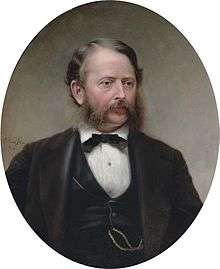 John Frederick Kensett (David Johnson, 1874) | |
| Born | March 22, 1816 |
| Died | December 14, 1872 (aged 56) New York City |
| Nationality | American |
| Known for | Painting, Landscape art, Engraving |
| Movement | Luminism |
Biography
He was born on March 22, 1816. Kensett attended school at Cheshire Academy, and studied engraving with his immigrant father, Thomas Kensett, and later with his uncle, Alfred Daggett. He worked as engraver in the New Haven area until about 1838, then went to work as a bank note engraver in New York City.
In 1840, along with Asher Durand and John William Casilear, Kensett traveled to Europe in order to study painting. There he met and traveled with Benjamin Champney. The two sketched and painted throughout Europe, refining their talents. During this period, Kensett developed an appreciation and affinity for 17th century Dutch landscape painting. Kensett and Champney returned to the United States in 1847.
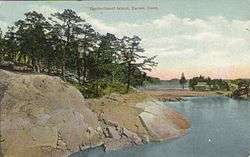
Established studio

After establishing his studio and settling in New York, Kensett traveled extensively throughout the Northeast and the Colorado Rockies as well as making several trips back to Europe.
Kensett is best known for his landscape of upstate New York and New England and seascapes of coastal New Jersey, Long Island and New England. He is most closely associated with the "second generation" of the Hudson River School. Along with Sanford Robinson Gifford, Fitz Henry Lane, Jasper Francis Cropsey, Martin Johnson Heade and others, the works of the "Luminists", as they came to be known, were characterized by unselfconscious, nearly invisible brushstrokes used to convey the qualities and effects of atmospheric light. Such effects stemmed from Transcendentalist philosophies of sublime nature and contemplation bringing one closer to a spiritual truth. In 1848 he was elected into the National Academy of Design as an Associate member, and became a full Academician in 1849.
In 1851 Kensett painted a monumental canvas of Mount Washington that has become an icon of White Mountain art. Mount Washington from the Valley of Conway was purchased by the American Art Union, made into an engraving by James Smillie, and distributed to 13,000 Art Union subscribers throughout the country. Other artists painted copies of this scene from the print. Currier and Ives published a similar print in about 1860. This single painting by Kensett helped to popularize the White Mountain region of New Hampshire.
Kensett's style evolved gradually, from the traditional Hudson River School manner in the 1850s into the more refined Luminist style in his later years. By the early 1870s Kensett was spending considerable time at his home on Contentment Island, on Long Island Sound near Darien, Connecticut.
It was during this time that Kensett painted some of his finest works. Many of these were spare and luminist seascapes, the prime example being Eaton's Neck, Long Island (1872) now in the collection of the Metropolitan Museum of Art in New York.
The artist was widely acclaimed and financially successful during his lifetime. In turn, he was generous in support of the arts and artists. He was a full member of the National Academy of Design, the founder and president of the Artists' Fund Society, and a founder and trustee of the Metropolitan Museum of Art.
Death
Kensett contracted pneumonia (perhaps during the attempted rescue of Mary Lydia (Hancock) Colyer, the wife of his friend and fellow artist Vincent Colyer in Long Island Sound) and died of heart failure at his New York studio in December 1872. Kensett is interred at Green-Wood Cemetery in Brooklyn, New York. In 1874 Kensett's brother Thomas gave thirty-eight of his paintings to the Metropolitan Museum of Art, of which half remain in the collection.[3]
Legacy
The first complete biography and factual study of Kensett's work was written by Ellen H. Johnson, published in 1957.
Paintings
 Trout Fisherman, oil on canvas, 1852. Thyssen-Bornemisza Museum
Trout Fisherman, oil on canvas, 1852. Thyssen-Bornemisza Museum Upper Mississippi, oil on canvas, 1855. St. Louis Art Museum
Upper Mississippi, oil on canvas, 1855. St. Louis Art Museum Lake George, c. 1870, Princeton University Art Museum
Lake George, c. 1870, Princeton University Art Museum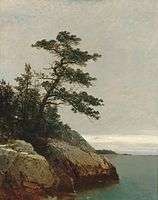 The Old Pine, Darien, Connecticut, c. 1872, Metropolitan Museum of Art, New York City
The Old Pine, Darien, Connecticut, c. 1872, Metropolitan Museum of Art, New York City View of the Beach at Beverly, Massachusetts, oil on canvas, 1860. Santa Barbara Museum of Art
View of the Beach at Beverly, Massachusetts, oil on canvas, 1860. Santa Barbara Museum of Art Lake George, 1860–1869. Thyssen-Bornemisza Museum
Lake George, 1860–1869. Thyssen-Bornemisza Museum.jpg) Mount Washington from the Valley of Conway, 1869, The Wellesley College Museum
Mount Washington from the Valley of Conway, 1869, The Wellesley College Museum Lake George – Brooklyn Museum
Lake George – Brooklyn Museum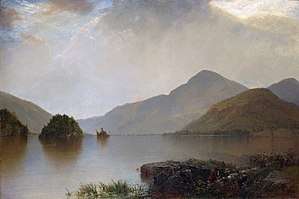 Lake George, oil on canvas, 1869, Metropolitan Museum of Art, New York City, has been called "one of the culminating works of the American tradition that began with Cole and Durand, both of whom had painted the lake."[4]
Lake George, oil on canvas, 1869, Metropolitan Museum of Art, New York City, has been called "one of the culminating works of the American tradition that began with Cole and Durand, both of whom had painted the lake."[4]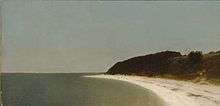 Eaton's Neck, Long Island in New York, 1872, The Metropolitan Museum of Art
Eaton's Neck, Long Island in New York, 1872, The Metropolitan Museum of Art
Notes
- Barringer and Wilton, 25
- Barringer and Wilton, 204–209
- Barringer and Wilton, 208
- Barrington and Wilton, 134
References
- Barringer, Tim and Wilton, Andrew. American Sublime: Landscape Painting in the United States 1820-1880, Princeton University Press, 2002. ISBN 0-691-09670-8
- Driscoll, John Paul and John K. Howat. John Frederick Kensett, An American Master, W. W. Norton & Company: New York, New York, 1985.
- Johnson, Ellen Hulda. "Kensett Revisited", The Art Quarterly, Spring 1957, pp. 71 – 92.
Further reading
- Trafton, Melissa Geisler. " 'It is a Joint Venture': John Frederick Kensett's Images for Lotus-Eating", American Art, vol. 25, no. 2, Summer 2011, pp. 104–119.
- Sullivan, Mark W. "Meaning in John F. Kensett's October Day in the White Mountains", Cleveland Studies in the History of Art, Vol. 6 (2001), pp. 48–61.
- Sullivan, Mark W. "John F. Kensett at Newport: The Making of a Luminist Painter," The Magazine Antiques, Vol. 138, No. 5 (November 1990), 1030-1041.
- Sullivan, Mark W. "John F. Kensett, American Landscape Painter." Diss., Bryn Mawr College, 1981.
- Levitt, Ruth. Kensett: Artisans in Britain and America in the 18th and 19th centuries. https://kclpure.kcl.ac.uk/portal/files/31058138/KENSETT_by_RUTH_LEVITT_2014.pdf%5B%5D. London, King's Research Portal, November 2014.
External links
| Wikimedia Commons has media related to John Frederick Kensett. |
- American Paradise: The World of the Hudson River School, an exhibition catalog from The Metropolitan Museum of Art (fully available online as PDF), which contains material on Kensett (see index)
- Art and the empire city: New York, 1825-1861, an exhibition catalog from The Metropolitan Museum of Art (fully available online as PDF), which contains material on Kensett (see index)
- Finding Aid to John Frederick Kensett Papers, 1830-1872 at the New York State Library, accessed May 18, 2016.
- White Mountain paintings by John Frederick Kensett
- www.JohnFrederickKensett.org 145 works by John Frederick Kensett